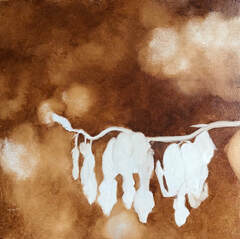 Value Study for "The Bleeding Heart" 12 x 12
Value Study for "The Bleeding Heart" 12 x 12 So learning to paint was practically unavoidable. I realized pretty quickly that I was a studio painter. Plein air almost killed me. If it wasn’t the wind blowing my canvas off, it was some bloody hailstorm or the unhappy observations that shadows moved faster than I could paint! So, because I am a sometime field naturalist and in love with nature, it became obvious that my camera would have to accompany me everywhere. The once-in-a-lifetime shot wasn’t just going to freeze-frame itself!
But nothing in life worth doing necessarily goes well and herein follows my sorry chronicle of doomed cameras. The pre-digital ones were the most challenging. You never knew what you had until it was much too late to take a second, better shot. Then there were out-and-out catastrophies like Jon’s stepping into a steep hole in the middle of the Grand River the night before we left town to go to my mother’s university graduation(yes, you read that right). I found out about this only because next morning I saw that he’d taken the time to remove all of the salmon flies from their cases so they wouldn’t rust, but had completely forgotten to take the soaked camera out of his fishing vest. He’s lucky to be alive, as is his friend to whom he lent my next camera. Unfortunately within it was an unfinished roll of a Beaver Valley birch forest carpeted with trillium which vaporized when Moose opened the (MY) camera to put his own roll in. Twenty years later, I have yet to successfully replace those shots taken at a particular time of year in a particular place.
The advent of digital photography simply extendeded my catalogue of camera disasters. One was smashed when an aggressive dog lunged at Jewell. This happened just shortly after she and Jon had both been bitten by a pit-bull type who had come through a fence to attack them. Jon had gotten the worst of it and had just attended a wedding reception rigged up with an IV Pump. When it looked like a new attack was imminent, I promptly dropped my camera onto the concrete and, with ducked for cover.
The next camera was greatly superior. I have a general rule, however, which I violated: never buy technology which is smarter than you are. For years I walked around with the instructions booklet in my pocket . That Canon EOS took terrific photos until the moment I stepped right off the sideboard where I had been trying to get the perfect shot of a large painting. Don’t ask. I walked away but the Canon never forgave me, expressing its disgust by releasing its lens lock at inopportune moments. Well, it was too heavy anyway.
All hail the invention of devices which are light but take good pictures! Even if it did nothing else, my beloved iPad would still make me happy. It was basically intuitive and I could immediately do closeups, long shots on the river and videos of the rhodos. It was followed by my iPhone, which takes brilliant pictures despite me. But a funny thing happened. Periodically one or the other of them would produce a truly splendid shot with unusual effects, but ones I could never replicate. I decided to put it down to magic.
Then, about a month ago while down in the park, I removed my sunglasses and actually donned my reading glasses. Didn’t I notice a category called “Portrait” so I gave it a shot, so to speak. Wow! A tiny wheel with five teeny-weeny options showed up. I did’t think their descriptors werere helpful, so I just tried them one by one. Abracadabra! Now I know how I accidentally took the wonderful photo of the stem of bleeding heart I am currently painting. If you want a softened background, select “Contour Light. If it's a stark contrast between the background and a light object, select “Spotlight” and Bob’s your uncle (if you also pay attention to the distance instructions). ” I should also mention that if you select "Portrait" before taking the photo, you can scroll the options after the fact. The only category that baffled me was “Stage Light” . I googled and found this:
StageLight is a professional lighting control app for the iPad based on Art-Net (DMX512 over IP). The software combines the classic hardware lighting console feeling with modern and intuitive user interaction design. The user interface is characterized by intelligent use of available space in combination with a huge level of flexibility.
Huh? Let me know if you understood that because I certainly didn't. Another post explained that it simply focuses on brightening the subject while darkening the background to absolute black. Now was that so hard? The writer of that first Google hit must have been a bureaucrat.
Still, thanks to the invention of reading glasses, all has been right in my little world until I opened
the iPad this morning. Overnight it had installed the new iPadOS.
Everything is different in iPhoto.
Just shoot me.

 RSS Feed
RSS Feed
